- Home
- Focal Point in Art
Focal
Point in Art: Creating Engaging Artworks
What is a focal point in art, why do we need one and how do we create one in our paintings? These are important questions we'll answer.
First let's explore the meaning of a focal point.
Then we'll look at examples and how to create a focal point with proven techniques like composition, values, color, details, and more.
 Learn to create a focal point.
Learn to create a focal point.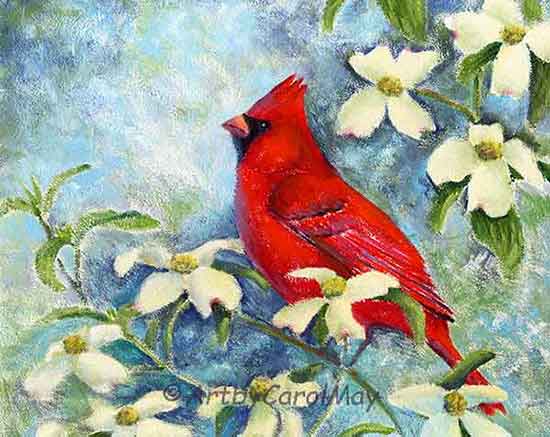 Learn to create a focal point.
Learn to create a focal point.What Is a Focal Point in Art?
The focal point is the main attraction in a painting.
It's the what and why the artist did the artwork. It attracts people and connects them to the artwork.
Why is a focal point important in our artwork?
Paintings without a center of interest runs the risk of being overlooked. Everything from landscapes to portraits, and even abstracts need a focal point.
Where Do We Put the Focal Point?
The focal point should be well integrated into the design of the entire painting.
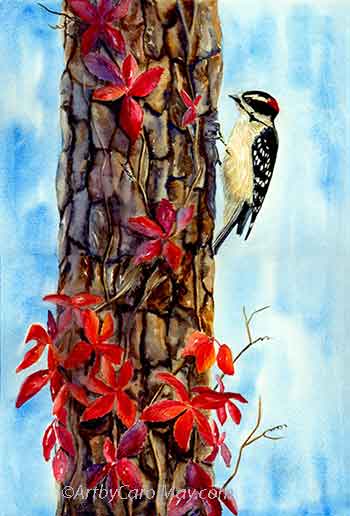 A well-placed focal point
A well-placed focal point- Generally, the focal point is placed "near" the center of the painting.
- The woodpecker painting is an example. The bird is slightly off-centered and well-integrated into the design of the painting.
The subject is almost never placed in the absolute center of the painting.
If the subject is dead-centered, the viewers are drawn to look at the subject and then leave the painting. They don't spend additional time looking at the rest of the painting.
Also, we don't
place the subject close to the edge of the painting. It will make the
viewers feel uncomfortable and possibly take them out of the painting.
The rule of thirds is a game-changer. It's a tried-and-true method of placing the focal point in a painting.
Leading Lines Bring Us to the Subject
How does the viewer get to the focal point? Lines in the compositions lead and direct the visitor to the main point of the painting.
We create a line of sight for the viewer to follow and arrive at the main subject of the artwork.
Common things we use are a road, a path, a river, a ravine or a fence. We could also use the line of roof-tops, clouds, ocean waves or any other part of the composition that creates a line.
We are accustomed to reading from left to right. So, the bottom left-hand side of the painting is the common place to paint a line leading into the artwork.
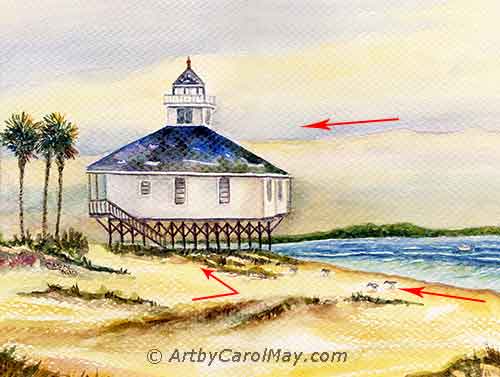
The clouds flow to the focal point. The beach edge leads to the lighthouse. Grasses come in and turn up toward the lighthouse.
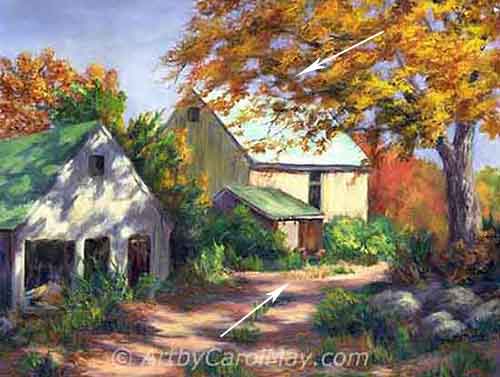
The road leads to the focal barn. The tree trunk and branch frame the barn. The tree foliage points down to the barn.
What Are Some Examples in Paintings?
What made the points of interest in these paintings? We'll talk more about the techniques in the next section.
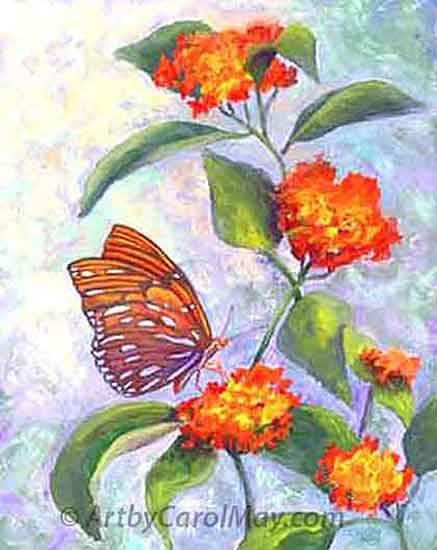
Animals are attention-getters. People are the same. Our eyes are attracted automatically to living things.
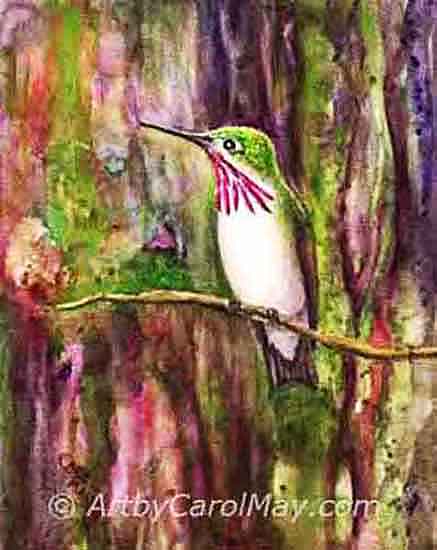
Contrast catches our attention. The difference between light and dark values stands out in a painting.
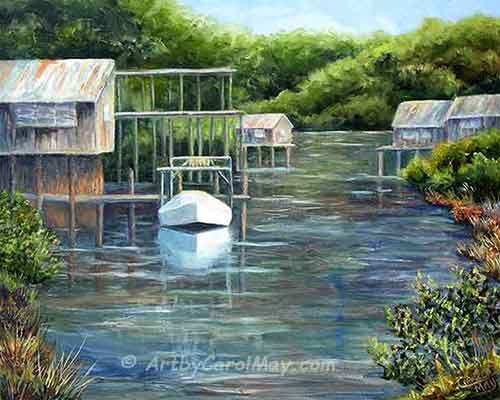
The subject is normally placed off-center. Very seldom would we place the subject in the exact middle of the painting.
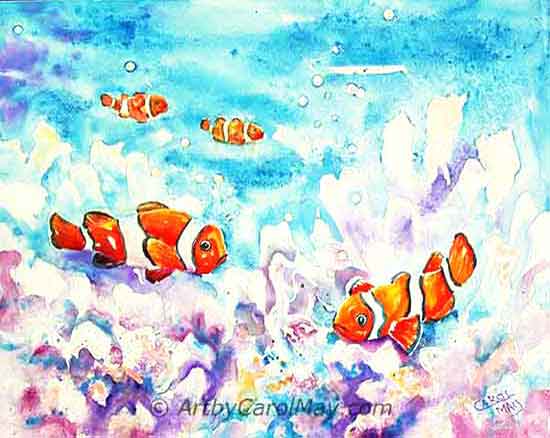
We can paint a second attention-getter. The line of sight between the fish directs our focus to the two focal points
How Do We Create a Focal Point in Art?
We know where to place a focal point, now what painting techniques can we use to amplify the center of interest?
In the art of painting, every part of the painting contributes to the creation of a focal point, from color and contrast to composition and detail.
Accomplished painting artists will use one or more of the following methods to create a focal point.
Contrasting Values Are Sure to Stand Out!
Values are the light and darkness of a color.
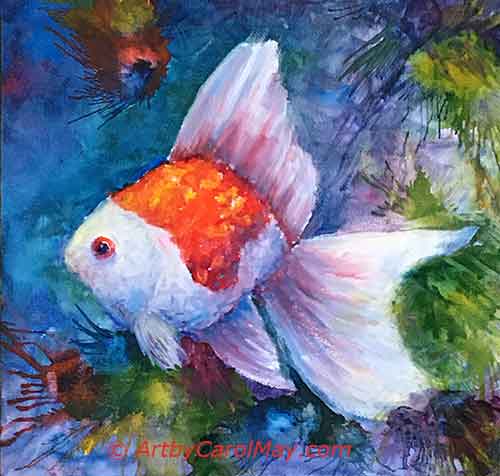 Light values contrast against the darks.
Light values contrast against the darks.Contrasting values are the #1 way to create a focal point in art.
Value contrast is the easiest way to make a focal point. The eye is automatically drawn to an area of high contrasting values.
Artists will use light against dark in many areas of the painting. But the focal area or point, should have the strongest value contrast.
The fish is obviously the focal point. Its white, red, orange and yellow contrast well with the dark colors of the background.
Red, orange and yellow are the lightest values on the artist color wheel.
Use Saturated Colors
The judicious use of color draws our eyes to the main subject of the painting.
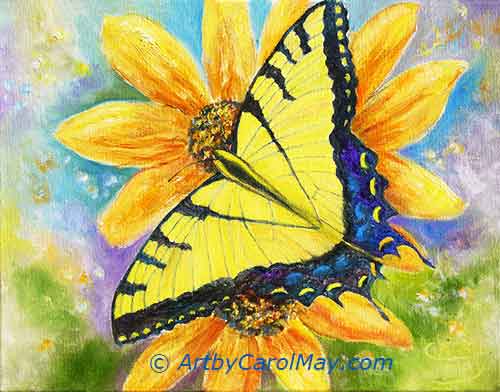 Bright colors contrast with subdued colors.
Bright colors contrast with subdued colors.An artist may use bright/saturated colors to draw attention to a specific area or subject.
Bright, clean colors contrast well with subdued colors.
The clean yellow and blue on the butterfly stand out from the subdued colors of the background.
Colors may be subdued by adding white, grey or black or mix them with their compliment.
The subdued colors look farther away than the clean, clear colors.
So, the flowers and the background behind the butterfly recede and bring the butterfly forward making him stand out.
Use Complements, Warm and Cool Colors
A set of complementary colors always consists of a warm and cool color.
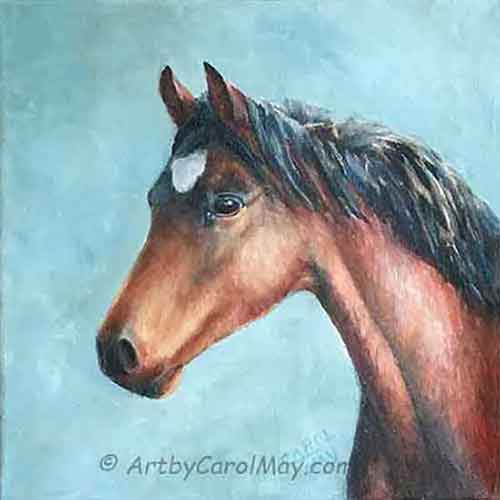 The warm horse shows off against cool colors.
The warm horse shows off against cool colors.Painting warm colors and cool colors beside each other is an attention-getter.
The warm colors, (red, orange and yellow) automatically attract attention.
When we place them against cool colors, (blue, green or purple) they really sparkle.
The horse's over-all warm colors really make it stand out against the cool colors of the background.
The colors of the mane and shadows were mixed from the warm sienna in the horse and the cool blue of the background. But even these dark colors are basically warm and contrast against the background.
Details Attract People
This butterfly painting uses six different techniques to bring our focus to the main butterfly.
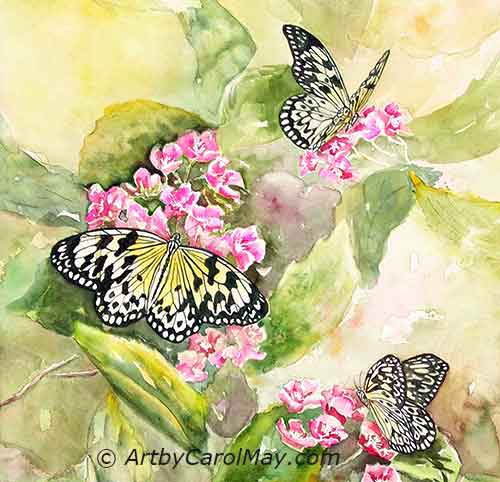 Details make the subject more important.
Details make the subject more important.Use more detail in the focal area compared to other areas of the painting.
People like details and they enjoy looking at them.
Our eyes are drawn to the intricate detail of the patterns on the butterfly's wings.
The large focal butterfly on the left has more details than the other two smaller ones.
There are five more techniques used on the focal point in this painting.
Soft and Hard Edges
- Soft edges are easy to view and they recede.
- Hard edges attract attention and come forward. They draw attention to a focal subject.
The hard edges on the main butterfly bring him forward. The soft edges in the background push it back and make it recede.
Shapes
The focal butterfly and its flowers are a large shape compared to the shape of the other two butterflies with their flowers.
Notice three other techniques we already covered:
- The main butterfly has more value contrast than the other two butterflies. That keeps the focus on him.
- The lower right butterfly is directing our line of sight to the focal butterfly. The branch on the lower left is also pointing to the butterfly. Both are leading lines.
- The focal butterfly has more saturated colors, compared to the other butterflies and the background.
Easy, Automatic Focal Points
How do we know our focal point will work?
Some things have a pull on the human psychic. Consequently, they make automatic focal points.
People and Animals
People or animals become the star of the show when they are in a painting.
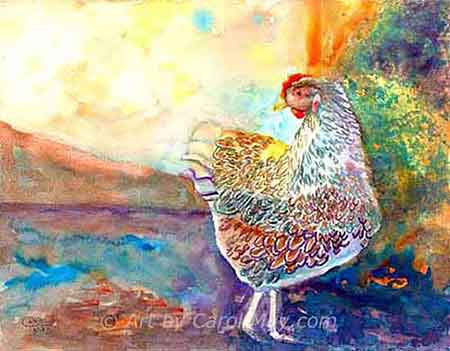 Animals are automatic focal points.
Animals are automatic focal points.Most people enjoy both domestic and wild animals. So, all types of critters always attract people.
Give people or animals plenty of space in front of their face.
Even though there is a lot of detail on the chicken and in the background, there a couple of differences.
She is painted with hard edges and saturated colors. This pulls her forward and makes her the focus.
Notice that the only red in the painting is the hen's comb and wattles. Red is a great for attracting attention. Use the meaning of colors in your artwork.
Solitary Objects Will Be the Star of the Show
Solitary items automatically attract attention.
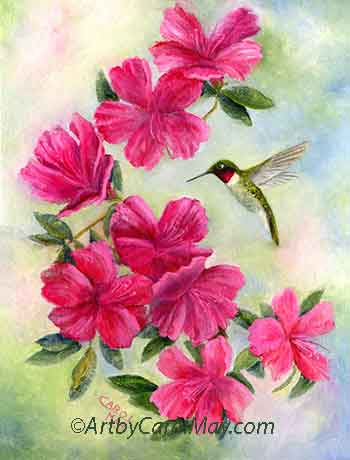 A single object is a focal point.
A single object is a focal point.This hummingbird has multiple things going for it that call attention to itself.
First, we know animals, as well as birds, automatically attract the viewer's attention.
Second, it is a solitary item. It's flying, all by itself out away from the flowers, so it stands out.
Third, it demands attention because it is small compared to the mass of flowers. Contrasting sizes attract attention.
It could
be the other way around with a large mass as the attraction, like the butterfly and flowers above.
Fourth, it has other techniques used to create a focal point; contrasting values, intense color and hard edges.
Buildings and Vehicles Are Attention-getters
Things such as vehicles, buildings, bridges, boats, etc. will attract our attention.
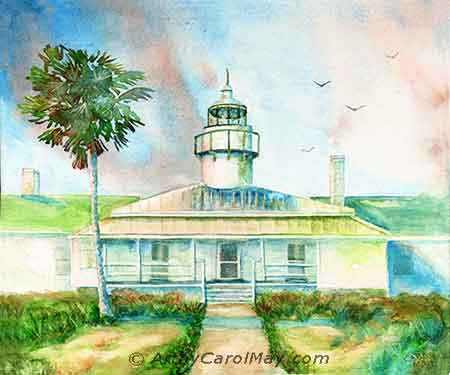 Man-made things draw us into a painting.
Man-made things draw us into a painting.Any man-made things will automatically be the center of interest in our paintings.
The hard lines and angles of man-made things attract our attention.
Notice the rigid, structural lines of the building compared to the grass and shrubs in the landscape. The building is the attention-getter.
Formal buildings are normally painted in a symmetrical composition, but the palm tree changes the it.
Eyes Always Attract Our Attention
The eyes of people or animal grab our gaze and pull us into a painting. They are an automatic focal point in art.
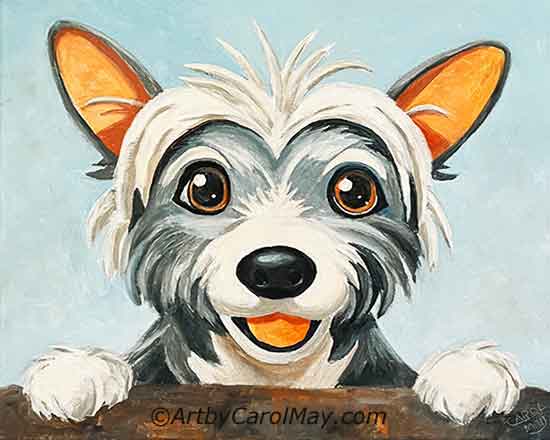 Notice how our attention goes to the eyes.
Notice how our attention goes to the eyes.Should a Painting Have Only One Focal Point?
Some paintings may have more than one center of interest. They have a main subject with supporting points of interest.
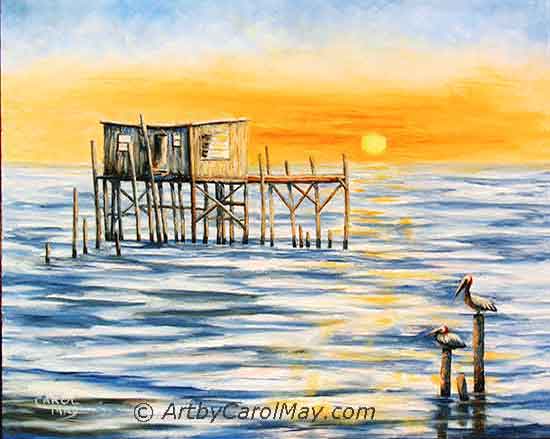
This is a painting with multiple points of interest. The cottage is the main one, pelicans are second and the sun is third.
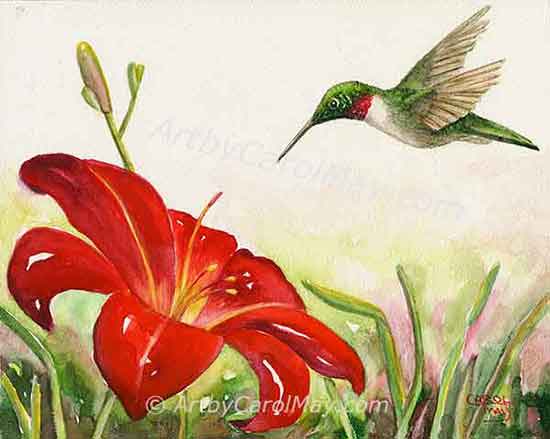
This painting has two focal points. The hummingbird is the center of interest. The daylily is the supporting focal point.
People Also Ask
How Can I Tell If There Are Too Many Focal Points?
How Can I Tell If There Are Too Many Focal Points?
What do you notice when you first look at your painting?
Do you look at one main thing or do your eyes jump from place to place. If that is the case, the piece may have too many focal points or they need adjustment.
One focal point should be more dominant. It should have one or more of these things to bring our focus; greater value contrast, more saturated colors, complementary colors, have more detail, texture, or hard edges.
These things will make one area dominant over the others. It will create one, main focal point.
How Do We Find the Focal Point in a Painting?
How Do We Find the Focal Point in a Painting?
As soon as we look at a piece of artwork, what do we look at?
We can't help it; our eyes are automatically drawn to the focal point.
Is a Focal Point One Specific Thing?
Is a Focal Point One Specific Thing?
The center of interest in a painting may be one specific thing. Or it may be an area with several items of interest.
In this case. we call it the focal area. They both function the same and attract people to enjoy our paintings.
Why Is a Focal Point Important in Our Artwork?
Why Is a Focal Point Important in Our Artwork?
Paintings need a focal point to connect with the viewers. Everything from landscapes to portraits, even abstracts need a focal point.
Artwork without a focal point runs the risk of being overlooked.
Does Every Painting Have a Center of Interest?
It is up to the artist whether they paint a center of interest or not. There is no law that says a painting has to have a focal point.
This fish painting does not have a focal point; it has no specific area of focus. It basically is a painting of detailed patterns.
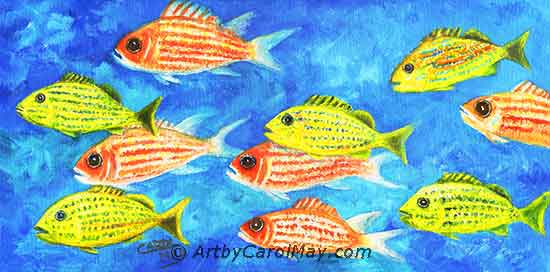 This is a painting of patterns.
This is a painting of patterns.Composition Notes: The two fish in the center overlap each other to hold the viewer's eyes inside the painting. Since the fish are all moving to the left, I didn't want them to carry our eyes out of the painting.
Also notice the left fish are not touching the edge of the canvas. That keeps our eyes inside the painting. Get more tips on compositions in art.
Review: What Makes a Focal Point in Art?
Let's see if we can spot what makes this bluebird the focal point.
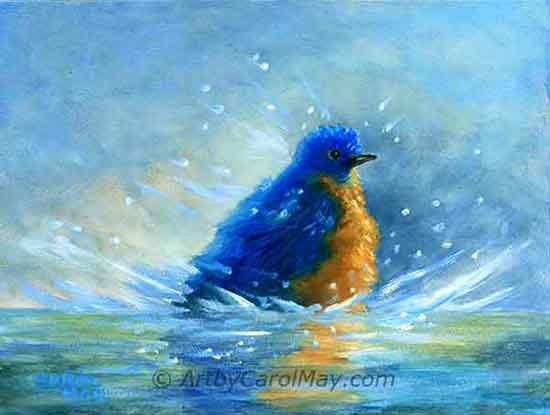 Complimentary colors, warm vs cool colors
Complimentary colors, warm vs cool colorsThis bluebird has several things that make him the focal point of the painting.
- He is complementary colors, blue and orange.
- Hard edges are painted on the bird, compared to the soft edges in the background
- He is bright, saturated colors.
- There is plenty of space in front of his face, so the viewer stays in the painting.
- Warm versus cool colors in the entire painting are a nice attraction.
Do you think I missed one?
Yes, he is a solitary object and a bird or animal. Also, the painting shows movement, that's another attraction.
It's easy to create a focal point in art with multiple methods.
Use any or all of these techniques to make a focal point in your paintings. They will be sure to create an attractive painting.






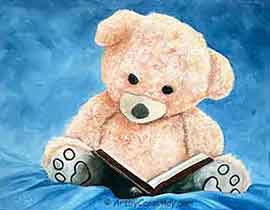 Are you eager to learn how to oil paint? What are the essential supplies for oil painting? What do we need for clean-up and how long do oil paintings take to dry? Learn the rules of oil painting and t…
Are you eager to learn how to oil paint? What are the essential supplies for oil painting? What do we need for clean-up and how long do oil paintings take to dry? Learn the rules of oil painting and t…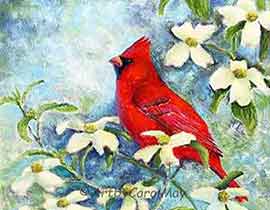 How do we create a focal point in art? Where do we put the focal point? How do we find the focus of an artwork? Should all paintings have a center of interest or can they have more than one? Learn fro…
How do we create a focal point in art? Where do we put the focal point? How do we find the focus of an artwork? Should all paintings have a center of interest or can they have more than one? Learn fro…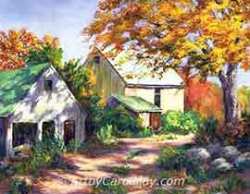 Art elements and principles appear over and over in good paintings. The elements and principles work together for us to create successful artwork. Art principles are the rules that govern how an artis…
Art elements and principles appear over and over in good paintings. The elements and principles work together for us to create successful artwork. Art principles are the rules that govern how an artis…